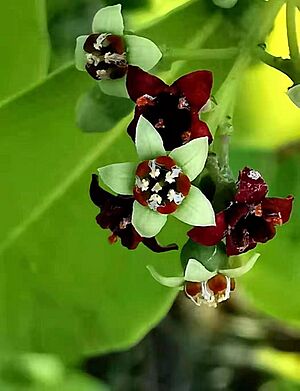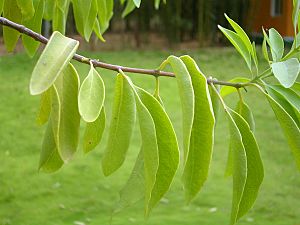Indian sandalwood facts for kids
Quick facts for kids Indian sandalwood |
|
|---|---|
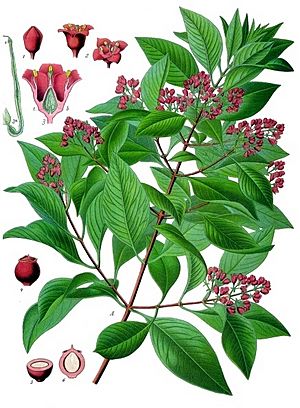 |
|
| Conservation status | |
| Scientific classification | |
| Genus: |
Santalum
|
| Species: |
album
|
Indian Sandalwood (scientific name: Santalum album) is a small tropical tree. It is famous for its special, sweet-smelling wood and oil. This tree naturally grows in southern India and parts of Southeast Asia.
Many cultures, especially in religions like Hinduism, see Indian Sandalwood as sacred. Its wonderful smell is very important to them. Sadly, because this tree is so valuable, too many have been cut down. This means wild Indian Sandalwood trees are now at risk of disappearing forever. Even so, its oil is still very expensive. This is because it has a lot of a special ingredient called alpha santalol. However, since there aren't many big trees left, its wood isn't used for fancy woodworking as much anymore. Indian Sandalwood trees live for a long time, but they can only be harvested after many years.
Contents
All About Indian Sandalwood Trees
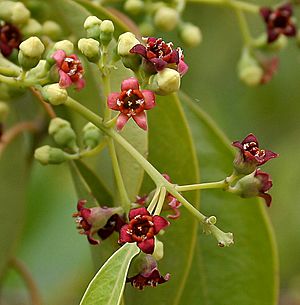
Indian Sandalwood trees are evergreen, meaning they keep their leaves all year. They can grow to be about 4 to 9 meters (13 to 30 feet) tall. Some of these trees can live for up to 100 years!
These trees are quite unique. They can grow straight up or spread out. They often grow tangled with other plants. Indian Sandalwood trees are special because they are "parasitic." This means their roots attach to the roots of other trees. They use a special part called a haustorium to get nutrients from their hosts. But don't worry, they usually don't harm the host trees much! One sandalwood tree can connect to many different plants, sometimes up to 300 kinds, including other sandalwood trees. These host plants help the young sandalwood tree by giving it important nutrients like phosphorus, nitrogen, and potassium. They also provide shade, which is very helpful when the tree is young.
The bark of the tree can be reddish, brown, or almost black. When the tree is young, the bark is smooth. As it gets older, it becomes cracked, showing a red color underneath. The inner wood, called the heartwood, is pale green to white. This is why it's sometimes called "white sandalwood."
The leaves are thin and grow in pairs. They are oval-shaped or long and narrow. The top of the leaf is shiny and bright green, while the underside is a pale, dull green. Indian Sandalwood trees start to produce fruit after three years. After five years, the seeds inside the fruit are ready to grow new trees. Birds help spread these seeds around.
Naming and History of Sandalwood
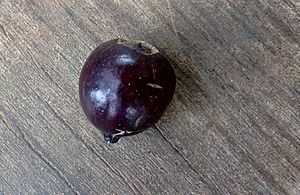
The name "sandalwood" comes from this specific tree. Its scientific name, Santalum album, is where other "sandalwoods" get their names. The word "sandalwood" comes from an old Sanskrit word, chandanam. This means "wood for burning incense" and is related to a word meaning "shining" or "glowing."
Santalum album belongs to the plant family called Santalaceae. It is often called white or East Indian sandalwood. The word album in its name means "white," referring to the color of its heartwood. This tree was the first one known as "sandalwood." Other trees in the Santalum family, like the Australian sandalwood (S. spicatum), are also called true sandalwoods. This helps tell them apart from other trees that just have a similar smell.
Where Indian Sandalwood Grows
Indian Sandalwood is originally from the tropical areas of India, eastern Indonesia, and northern Australia. It mostly grows in the drier tropical parts of India and on the Indonesian islands of Timor and Sumba. There's still a discussion about whether it's truly native to Australia and India. Some think it might have been brought there by fishermen, traders, or birds many centuries ago from Southeast Asia.
Today, Indian Sandalwood is grown in many countries. These include India, Sri Lanka, Indonesia, Malaysia, the Philippines, and Northern Australia.
How Indian Sandalwood Grows
Indian Sandalwood trees can be found in dry forests near the coast, up to about 700 meters (2,300 feet) high. They usually prefer sandy soils or well-drained rocky red soils. However, they can grow in many different types of soil. These trees like warm weather, from 0 to 38 degrees Celsius (32 to 100 degrees Fahrenheit). They also need a good amount of rain, between 500 mm and 3000 mm (20 to 120 inches) each year.
Indian Sandalwood trees need plenty of sunlight to grow well and don't need a lot of water. The tree starts to flower after about 7 years. When the flowers are young, they are white. As the tree gets older, the flowers turn red or orange. The trunk of the tree begins to develop its famous fragrance after about 10 years of growing.
Protecting Indian Sandalwood
Indian Sandalwood is listed as a "vulnerable" species by the International Union for the Conservation of Nature (IUCN). This means it's at risk of becoming extinct. The biggest threats are:
- Over-harvesting: Too many trees being cut down.
- Habitat loss: Changes in land use, like clearing land for farming.
- Fires: The trees are very sensitive to fire.
- Diseases: A plant disease called "Spike disease" also harms them.
To help save this special tree, laws have been put in place to protect it. People are also researching and developing ways to grow more sandalwood trees.
Before 2002, people in India were not allowed to grow sandalwood trees on their own land. Because the wood was so rare, individuals were not allowed to cut or harvest it. Only government officials could get special permission to cut down trees and sell the wood. The Indian government has also stopped the export of sandalwood timber to help protect the species.
Uses of Sandalwood and Its Oil
Santalum album has been the main source of sandalwood and its oil for a very long time. These products are very important in the cultures where the tree naturally grows. Only the central part of the tree, called the heartwood, is used for its amazing fragrance. This heartwood is yellow-brown, hard, and feels oily. It's also very strong, making it perfect for carving. The outer part of the tree, called the sapwood, doesn't have a smell. It's white or yellow and is used to make things like small turned wooden items.
Because sandalwood is so valuable, people have tried to grow it in more places. This has helped the tree spread to new areas. The oil from Indian sandalwood has a very high amount of santalol, about 90%. This is much higher than other sources, like Australian sandalwood, which has about 39%. India used to be the biggest producer of sandalwood oil in the world. However, in the 21st century, the industry has become smaller.
It takes a long time for the tree to grow and mature, and it can be hard to grow many of them. This has limited how much it can be planted. Harvesting the tree also involves several steps to prepare and process the wood, which adds to its high price. Both the wood and the oil are in high demand and are important trade items in three main regions:
Sandalwood in India
People in India have used Santalum album for over two thousand years. It is mentioned in old writings. The wood and oil are used in religious ceremonies. The wood has also been used to build temples and other structures. To stop too many trees from being cut down, the Indian government has banned exporting the wood.
Until 2001-2002, in the southern Indian states of Karnataka, Andhra Pradesh, and Tamil Nadu, any sandalwood tree bigger than a certain size belonged to the state. Even if a tree was on private land, the Forest Department controlled when it could be cut. After 2002, private growers were allowed to sell trees, but only to the state forest department. The amount of sandalwood produced in India has dropped a lot. In the early 1970s, about 4,000 tonnes were produced each year. By 2011, it was less than 300 tonnes. This drop is due to government rules and too much harvesting. Now, efforts are being made to encourage people to grow the trees again.
Sandalwood in Australia
In Australia, the native species, Santalum spicatum, is more common and widely grown in Western Australia. However, as of 2020, there are two large farms growing Indian sandalwood in northern Western Australia, near Kununurra. One company, Quintis, controlled about 80% of the world's Indian sandalwood supply in 2017. The other company is Santanol.
Sandalwood in Sri Lanka
For harvesting sandalwood, older trees are preferred. However, trees as young as seven years old can also be used. The whole tree is removed, not just cut at the base. Over the last century, so many Santalum album trees were removed in Sri Lanka that the species became much more vulnerable to extinction there.
As of 2020, small farms of Indian sandalwood also exist in China, Indonesia, Malaysia, the Philippines, and the Pacific Islands.
Images for kids
See also
 In Spanish: Sándalo para niños
In Spanish: Sándalo para niños



